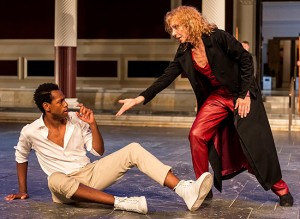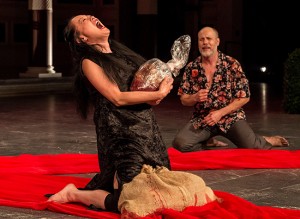Cultural Cocktail Hour
Theater Review: Under Bacchae’s spell- a MUST SEE production at the Getty Villa
Under Bacchae’s Spell
By
Leticia Marie Sanchez
The first few moments of Euripides’ Bacchae at the Getty Villa set the tone for the entire evening. Screaming Jay Hawkins’ raw, electrifying 1956 blues hit “I Put a Spell on You” plays in the outdoor theater, jolting the audience as the spartanly dressed Bacchanalian chorus emerges from classical columns. Their fearless leader Dionysus, the god of theater, wine, and divine ecstasy, is played with hypnotic magnetism by Ellen Lauren, who struts onto the stage in red leather pants like Mick Jagger on fire.
Through the direction of Anne Bogart from the New York-based SITI Company, one cannot help but be gripped. Euripides’ Bacchae is heavy material, but Bogart skillfully unearths comedic gems, Bacchanalian beats, and horrific depths so that within 90 minutes, the audience is at turns highly entertained and terrified.
Bogart’s direction uses a theatrical chiaroscuro, juxtaposing shades of light and dark, offering moments of hilarity to contrast with moments when the narrative plummets into the abyss. Bogart’s direction is successful because it allows the audience to understand how a character like Dionysus can so easily seduce legions of followers with playful tones, before revealing his sinister, vengeful side.

Ellen Lauren as Dionysus is a revelation, reeling us in with her massive charisma and verbal and physical prowess. Lauren’s voice and body dance through the prose of fourth century B.C, making it come alive for an audience in 2018. The pulsing beats of Darron West’s sound design enhance the atmosphere, the music complementing the text so that audience feels as though we are sitting at a Bacchanalian rave.
“Bacchae” at the Getty Villa. Photo by Craig Schwartz. Left to Right: Eric Berryman (Pentheus) and Ellen Lauren (Dionysus)
Other elements of the production also bring the themes to the forefront. The set is sparse as are the costumes, save for a few colorful flourishes like Cadmus’ Hawaiian shirt and Tiresias’ and floral fishing hat. The simplicity of the design provides a sharp relief to the intensity of the emotional impact of Bacchae. This ensures that the audience will not be distracted from the onslaught of emotions onstage. The cornerstone of this production is the stellar cast, including Ellen Lauren and Eric Berryman, who despite being a villain, cannot help but be likeable even when he is indignant as Thebes’ hubris-filled ruler Pentheus. Leon Ingulsrud also draws us in when he, as the First Messenger, conveys the eerie Bacchanalian rites.
After one of the most horrifying events, Agave, mother of brutally butchered Pentheus has not grasped what has happened. In this scene, she speaks entirely in Japanese. The Director’s Addendum notes that theater “transcends language.” But, I would posit a second benefit to this unusual directing choice. Agave (played by Akiko Aizawa) at this moment, stands in her own world. This scene showcases dramatic irony at its finest. The audience knows exactly what has happened and longs to reach out to Agave, but she simply doesn’t get it. Her use of another language conveys that she stands apart in her own dimension, her own reality.
Another unusual and effective choice is the casting of Dionysus as a woman. One theme of the play is the dangerous irrationality that men fear in women. In fact, Pentheus’ downward spiral begins when he hears that his own mother has taken part in Bacchanalian rites. The Madonna/Whore dichotomy rears its ubiquitous head; unable to envision his mother this way, Pentheus, in front of the audience, begins to have a mental breakdown. Therefore, having Ellen Lauren personify the dangerous potential attributed to women makes perfect sense in the context of the play.
In the last scene, Dionysus emerges donning a Janitor costume as he sops up the bloody murderous mess. Why the Janitor gear? Dionysus warns the audience that the supernatural comes in many shapes. Perhaps a suggestion to be careful whom you insult. Do not disparage someone whom you consider to be low-status (as happened to Dionysus before he meted out the supreme revenge).

Despite this potentially good message, the play could have more effectively ended with the prior scene.The comedic last scene of Dionysus dressed like a sitcom janitor and Cadmus flopping on his belly like a serpent undercuts the emotional impact. It does not allow us to fully process the sickening horror we have just witnessed. We need time to wallow in this chilling tragedy. The penultimate scene is like a horror film. Cutting the last scene entirely and ending on that dark note would allow the audience to walk out of the theater with maximum emotional impact.
“Bacchae” at the Getty Villa. Photo by Craig Schwartz. Left to right: Akiko Aizawa (Agave) and Stephen Duff Webber (Cadmus).
However, Anne Bogart’s production of Bacchae at the Getty Villa is a must-see production to the charismatic cast, creative direction, and mesmerizing design elements.
Bacchae by Euripides
September 6-29, 2018
Thursdays-Saturdays, 8:00 p.m.
The Barbara and Lawrence Fleischman Theater at the Getty Villa













